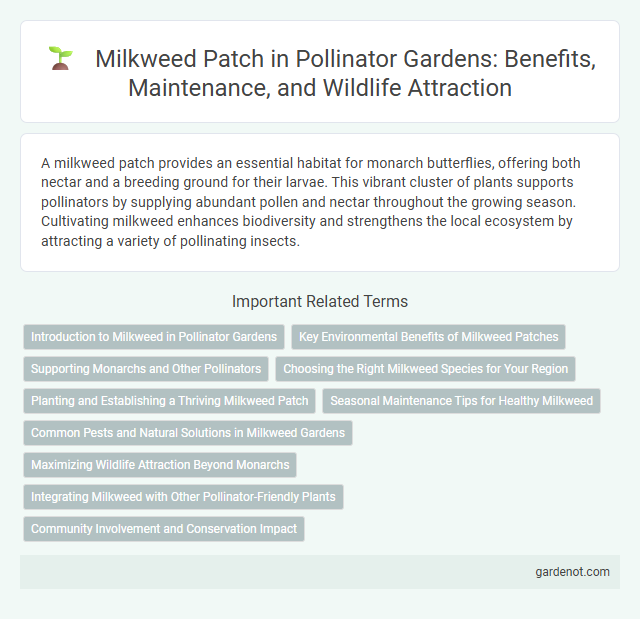A milkweed patch provides an essential habitat for monarch butterflies, offering both nectar and a breeding ground for their larvae. This vibrant cluster of plants supports pollinators by supplying abundant pollen and nectar throughout the growing season. Cultivating milkweed enhances biodiversity and strengthens the local ecosystem by attracting a variety of pollinating insects.
Introduction to Milkweed in Pollinator Gardens
Milkweed is a keystone plant essential for pollinator gardens, serving as the primary host for monarch butterfly larvae and attracting a wide variety of pollinators, including bees and hummingbirds. Its nectar-rich flowers bloom from late spring through fall, providing a continuous food source that supports pollinator population growth and biodiversity. Cultivating a milkweed patch promotes ecological balance by enhancing habitat connectivity and encouraging natural pest control.
Key Environmental Benefits of Milkweed Patches
Milkweed patches provide essential habitat and food sources for monarch butterflies, contributing to their conservation and supporting pollinator biodiversity. These patches improve soil health by preventing erosion and enhancing nutrient cycling through deep root systems. Milkweed also plays a critical role in promoting ecological balance by attracting various beneficial insects and supporting native plant growth.
Supporting Monarchs and Other Pollinators
Milkweed patches serve as critical habitats for monarch butterflies, providing essential breeding grounds and larval food sources that support their life cycle and population growth. These patches also attract a diverse array of other pollinators, including native bees and butterflies, enhancing local biodiversity and promoting effective pollination. Planting and maintaining milkweed habitats contribute significantly to the conservation of monarchs and the overall health of pollinator ecosystems.
Choosing the Right Milkweed Species for Your Region
Selecting the right milkweed species for your pollinator garden depends on your local climate and soil conditions, as native varieties support regional monarch butterfly populations. Common regional species include Asclepias tuberosa for well-drained sunny areas, Asclepias incarnata for moist soils, and Asclepias syriaca for diverse habitats. Planting native milkweed enhances pollination success and provides essential larval host plants for monarch butterflies in your area.
Planting and Establishing a Thriving Milkweed Patch
Planting a thriving milkweed patch requires selecting native species suited to the local climate and soil conditions, such as Asclepias tuberosa or Asclepias syriaca, to support monarch butterflies effectively. Establish the patch in full sun with well-drained soil, spacing plants 12-18 inches apart to allow for healthy growth and air circulation. Consistent watering during the first growing season and minimal disturbance after establishment promote robust root systems and abundant blooms critical for pollinator attraction.
Seasonal Maintenance Tips for Healthy Milkweed
Pruning milkweed in late fall or early spring promotes healthy regrowth and reduces the risk of disease, while removing old seed pods prevents unwanted spreading. Regularly checking for aphids and gently washing them off helps maintain plant vigor without harming beneficial insects. Mulching around the base conserves moisture and regulates soil temperature, supporting a thriving milkweed patch each season.
Common Pests and Natural Solutions in Milkweed Gardens
Common pests in milkweed patches include aphids, milkweed bugs, and caterpillars that can damage leaves and reduce plant vigor. Encouraging natural predators such as ladybugs, lacewings, and parasitic wasps helps control pest populations without harmful chemicals. Planting diverse companion species and maintaining healthy soil conditions promotes a balanced ecosystem that supports natural pest management in milkweed gardens.
Maximizing Wildlife Attraction Beyond Monarchs
A milkweed patch provides essential nectar and habitat not only for Monarch butterflies but also attracts a diverse range of pollinators including bees, hummingbirds, and other butterfly species. By planting multiple milkweed varieties, the garden supports different pollinator life cycles throughout the growing season, enhancing biodiversity and ecological stability. Dense clusters of milkweed flowers increase pollination efficiency and create a thriving microhabitat for beneficial insects and wildlife.
Integrating Milkweed with Other Pollinator-Friendly Plants
Integrating milkweed with other pollinator-friendly plants like coneflowers, black-eyed Susans, and bee balm enhances garden biodiversity and supports a wider range of pollinators including monarch butterflies, bees, and hummingbirds. Combining these species creates a continuous bloom period and diverse nectar sources, fostering a resilient and thriving ecosystem within the pollinator garden. Strategically planting milkweed alongside complementary wildflowers also improves habitat structure and increases the overall attractiveness of the patch to beneficial insects.
Community Involvement and Conservation Impact
Milkweed patches serve as critical habitats for monarch butterflies, engaging local communities in hands-on conservation efforts that raise awareness about pollinator decline. Volunteers contribute to planting and maintaining these patches, fostering a collective stewardship ethos that strengthens community bonds and promotes biodiversity. The preservation and expansion of milkweed habitats directly impact monarch populations by providing essential resources for reproduction and migration survival.
Milkweed patch Infographic

 gardenot.com
gardenot.com